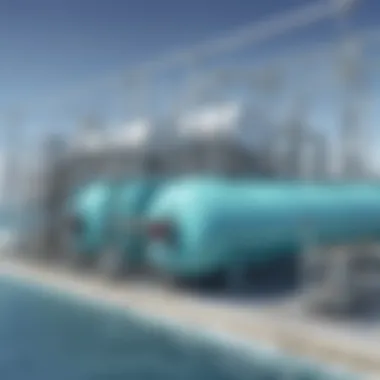Innovative Approaches for Removing Salt from Water Sources


Science Fun Facts
Desalination is the process of removing salt from seawater to make it safe for consumption. Contrary to popular belief, seawater is not drinkable due to its high salt content, which is harmful to the human body. Utilizing various methods, scientists have developed effective ways to extract salt from seawater, providing a vital source of fresh water for communities around the world. Isn't it mind-boggling how science enables us to transform something as abundant as seawater into a life-saving resource?
Discover the Wonders of Science
By delving into the realm of desalination, we encounter fascinating scientific concepts at play. Distillation, a process where water is boiled and then condensed to separate it from salts and impurities, showcases the principles of phase change and purification. On the other hand, reverse osmosis involves applying pressure to force water through a semipermeable membrane, leaving salt behind. These methods not only reveal the marvels of chemistry and physics but also demonstrate the ingenuity of human innovation in solving pressing environmental challenges.
Science Quiz Time
How well do you understand the science behind desalination? Here's a chance to test your knowledge with some interactive quizzes. Can you differentiate between distillation and reverse osmosis? What are the common sources of salt in seawater? Engage in brain teasers and puzzles to unravel the mysteries of salt removal and water purification. Learning through gamification makes complex scientific concepts both enjoyable and memorable for aspiring young minds.
Science Experiment Showcase
Embark on a scientific journey with fun and engaging experiments that simulate the desalination process. Gather materials such as a pot, ice, a bowl, plastic wrap, and salt to create a mini distillation setup at home. Follow step-by-step instructions to heat the saltwater, collect the condensed fresh water, and observe the residue left behind. Remember to prioritize safety by wearing gloves and protective eyewear during the experiment. Through hands-on activities, children can grasp the essence of desalination while fostering a passion for scientific exploration and innovation.
Introduction
As we delve into the realm of effective methods to eliminate salt from water, it becomes evident that this topic carries immense significance in addressing the growing need for fresh water resources globally. The process of removing salt from water plays a crucial role in ensuring access to potable water, a fundamental human right. By exploring various desalination techniques, we aim to shed light on the intricate mechanisms involved in transforming saline water into a viable source of hydration.
Understanding the Challenge
Why is removing salt from water important?
Embarking on the journey of understanding the pivotal role of salt removal from water, we encounter a fundamental aspect - the dire need for freshwater resources due to escalating water scarcity issues. The significance lies in the pressing demand for drinkable water, driven by population growth, environmental changes, and industrialization. Removing salt from water opens avenues for sustainable water supply, crucial for ecosystem preservation and human civilization's continuity. Despite challenges, the process stands as a beacon of hope for regions facing water stress, exemplifying resilience and innovation.
Challenges posed by saline water
Transitioning into the realm of challenges presented by saline water, we confront obstacles intertwined with desalination processes. The salinity levels in water bodies pose intricate hurdles, demanding advanced technologies and expertise for effective salt removal. From energy-intensive processes to environmental implications, saline water challenges encompass multifaceted dimensions. However, innovative solutions and strategic implementation can mitigate these challenges, paving the way for a sustainable water future.


Overview of Desalination
What is desalination?
Delving into the core of desalination unveils a transformative process centered on extracting salt from water, turning seawater into a vital resource. The essence lies in harnessing scientific principles to purify saline water, offering a ray of hope amid freshwater depletion concerns. Desalination emerges as a beacon of technological evolution, showcasing human ingenuity in combating water scarcity through innovative solutions.
Different desalination methods
Exploring the array of desalination methods reveals a diverse landscape of approaches tailored to distinct water environments and resource availability. From thermal distillation to membrane-based processes, desalination methods exhibit unique strengths and limitations, influencing their applicability in varied contexts. Understanding these methodologies provides a comprehensive outlook on how salt removal can be tailored to specific needs, fostering sustainability and resource optimization.
Methods of Salt Removal
Salt removal methods play a crucial role in water desalination. In this article, we delve into various techniques used to eliminate salt from water, highlighting their significance in addressing fresh water scarcity. By exploring methods like distillation, reverse osmosis, ion exchange, and electrodialysis, we aim to provide a comprehensive guide for efficiently obtaining fresh water from saline sources.
Distillation
Process of distillation
Distillation involves the separation of salt from water through evaporation and condensation. This method is widely recognized for its effectiveness in producing freshwater free from salt impurities. The unique feature of distillation lies in its simplicity; by heating saline water, capturing the evaporated vapor, and then condensing it back into liquid form, salt separation is achieved. However, distillation also presents limitations like high energy consumption and the need for advanced equipment for large-scale operations.
Advantages and limitations
Examining the advantages of distillation, we find that it offers a straightforward approach to salt removal, yielding high-quality freshwater output. Its ability to remove a wide range of impurities besides salt makes it a popular choice for water desalination projects. On the other hand, the limitations of distillation include its energy-intensive nature, making it less sustainable compared to other methods. Additionally, the initial setup costs and maintenance complexities pose challenges for widespread adoption in desalination initiatives.
Reverse Osmosis
Working principle of reverse osmosis
Reverse osmosis functions by applying pressure to saline water, forcing it through a semi-permeable membrane to separate salt molecules from the water. This method's key characteristic lies in its efficiency in removing salt particles, ensuring high-quality freshwater production. The unique feature of reverse osmosis is its ability to remove microscopic impurities effectively, providing a reliable source of freshwater. However, reverse osmosis also comes with drawbacks such as high energy requirements and the need for periodic membrane replacement.
Efficiency and drawbacks


Considering the efficiency of reverse osmosis, it stands out for its high salt removal rate, making it a preferred choice for many desalination plants. The process can produce large quantities of freshwater efficiently, meeting the increasing demand for clean water. Nonetheless, drawbacks include the dependency on electricity for operation, making it less environmentally friendly compared to certain alternative methods. Moreover, the excessive waste produced during the filtration process poses challenges in waste management for reverse osmosis facilities.
Ion Exchange
How ion exchange works
Ion exchange involves the removal of salt ions from water by exchanging them with other ions present on an exchange medium. This method's key characteristic lies in its selective removal of specific ions, allowing for tailored water purification. The unique feature of ion exchange is its versatility in targeting different types of salts, providing customized desalination solutions. However, ion exchange faces challenges such as the limited capacity of exchange mediums and the generation of concentrated brine waste.
Applications and challenges
Exploring the applications of ion exchange, it finds extensive use in industries requiring specific water quality standards, such as pharmaceutical and electronics manufacturing. Its ability to produce high-purity water makes it a popular choice for sensitive processes. Nevertheless, challenges emerge due to the operational costs associated with replacing exhausted exchange mediums and disposing of the concentrated brine waste, highlighting the need for sustainable practices in ion exchange desalination.
Electrodialysis
Mechanism of electrodialysis
Electrodialysis operates by passing saline water through ion-selective membranes under the influence of an electric field, separating salt ions from the water stream. This method's key characteristic lies in its continuous operation and scalability for large-scale desalination applications. The unique feature of electrodialysis is its ability to achieve high salt removal efficiencies while maintaining water flow rates. However, electrodialysis presents drawbacks such as high initial investment costs and susceptibility to membrane fouling.
Pros and cons
Examining the pros of electrodialysis, we note its efficiency in producing freshwater with low salt content, meeting various industrial and commercial water supply needs. The method's continuous operation also ensures a steady output of desalinated water, catering to consistent demand. Nonetheless, cons include the need for periodic maintenance to prevent membrane fouling which can impact system performance and increase operational expenditures. Additionally, the dependence on electricity for ion migration poses sustainability challenges that need to be addressed in electrodialysis systems.
Technological Innovations
In the realm of desalination, technological innovations play a pivotal role in advancing the efficiency and sustainability of salt removal processes from water sources. These advancements represent a significant departure from traditional methods, ushering in an era of increased efficacy and environmental consciousness. By focusing on continual improvement and integration of cutting-edge technologies, the field of desalination has witnessed a renaissance in its approach towards mitigating water scarcity issues globally.
Solar Desalination
Utilizing solar energy for desalination:
Solar desalination stands out as a groundbreaking approach in harnessing renewable energy sources for water purification. This method capitalizes on the abundant energy provided by the sun to drive the desalination process, making it a sustainable and eco-friendly solution. The key allure of utilizing solar energy lies in its cost-effectiveness and environmentally benign nature, making it an appealing choice for addressing water scarcity challenges. Despite its undeniable benefits, the reliance on sunlight for operation poses occasional limitations, especially in regions with inconsistent solar exposure.


Advancements in solar desalination technology:
The advancements in solar desalination technology have revolutionized the desalination landscape, offering enhanced efficiency and productivity. By incorporating innovative materials and refining system designs, modern solar desalination setups boast improved performance and reliability. The key characteristic of these advancements lies in their ability to optimize energy utilization and streamline the desalination process, marking a significant leap forward in the quest for sustainable water treatment solutions. However, challenges related to scalability and initial investment costs still present hurdles in widespread adoption of these technologies.
Graphene-Based Filters
Role of graphene in desalination:
Graphene's role in desalination showcases the extraordinary filtering capabilities of this versatile material. With its exceptional strength and molecular structure, graphene-based filters have redefined water treatment standards by enabling precise salt removal while maintaining high flow rates. The key characteristic of graphene lies in its ultra-thin yet robust nature, allowing for efficient filtration without sacrificing performance. The unique feature of graphene-based filters lies in their unrivaled filtration efficiency and durability, making them a preferred choice for sustainable desalination practices.
Efficiency of graphene filters:
The efficiency of graphene filters underscores their exceptional ability to separate salt from water with remarkable precision. By leveraging graphene's inherent properties, these filters offer unparalleled filtration rates and salt rejection capabilities, surpassing conventional filtration methods. The key characteristic of graphene filters is their scalability and adaptability to varying water treatment needs, providing a versatile solution for diverse desalination applications. Despite their exceptional efficiency, challenges related to production costs and material scalability pose hindrances in the widespread deployment of graphene filters in commercial desalination facilities.
Environmental Impact and Future Outlook
Understanding the crucial importance of Environmental Impact and Future Outlook within the context of desalination processes is paramount. As societies strive to harness advanced methods to remove salt from water, it becomes imperative to assess the broader repercussions on the environment. Environmental Impact and Future Outlook in desalination serve as key determinants of sustainability and ecological balance, demanding meticulous consideration at every stage of implementation. By scrutinizing the environmental impact and potential future trends, we can steer towards a more conscious and responsible approach in securing freshwater resources.
Environmental Considerations
Impact of desalination on the environment
The impact of desalination on the environment cannot be overstated. As we delve into the repercussions of this process, we unveil a complex web of consequences that intertwine with our ecological landscape. Desalination plants exhibit both advantages and disadvantages concerning their environmental footprint. It is crucial to dissect the key characteristics of this impact to underline why it stands as a critical focal point within the realm of desalination. Understanding the unique features that define the impact of desalination on the environment is essential to navigating our approach towards sustainable water management in the face of increasing demand.
Sustainable desalination practices
Exploring sustainable desalination practices unveils a realm of possibilities geared towards harmonizing water production with environmental preservation. The inherent contribution of sustainable practices towards mitigating the adverse effects of desalination is evident. These practices embody key characteristics that establish them as pivotal players in the quest for ecological equilibrium. Delving into the unique features that define sustainable desalination practices provides an insightful lens through which we can discern the advantages and disadvantages present in their integration within desalination processes.
Future Trends in Desalination
Innovations in desalination technology
The landscape of desalination technology is on the brink of transformation, fueled by relentless innovation and scientific advancement. Innovations in desalination technology epitomize the pinnacle of human ingenuity directed towards resolving global water challenges. Understanding the key characteristics that define these innovations is vital in comprehending their potential impact on revolutionizing water treatment practices. We unravel the unique features of these innovations to discern their advantages and potential drawbacks, paving the way for a comprehensive evaluation of their role in shaping the future of desalination.
Addressing global water scarcity
In the backdrop of mounting global water scarcity concerns, the imperative to address this pressing issue looms large. Strategies aimed at tackling global water scarcity form the cornerstone of future developments in desalination efforts. The key characteristics defining these strategies underscore their pivotal role in reshaping the water landscape on a global scale. By exploring the unique features embedded within these approaches, we gain insights into the advantages they offer in mitigating water scarcity challenges while also delving into potential disadvantages that warrant strategic consideration within the larger framework of water resource management.







